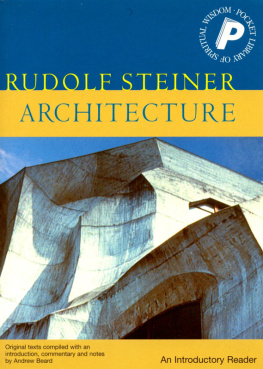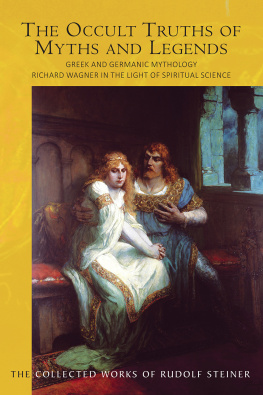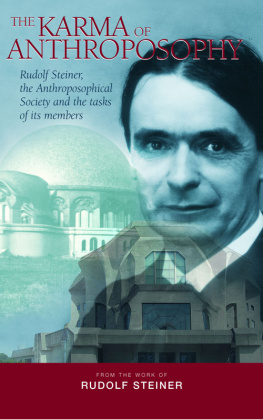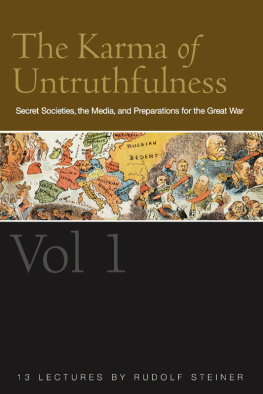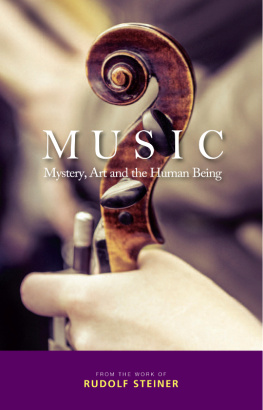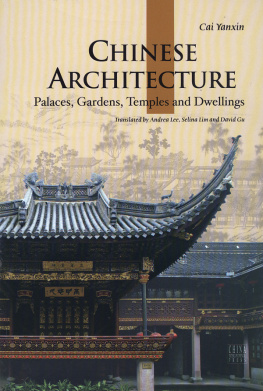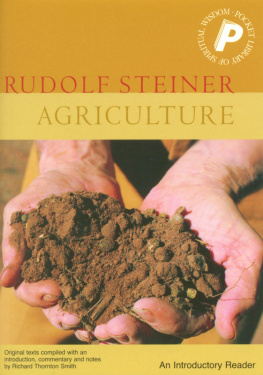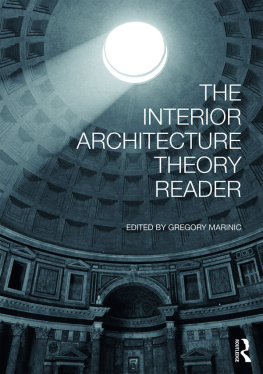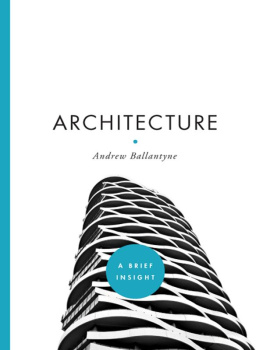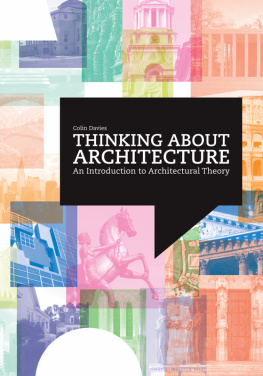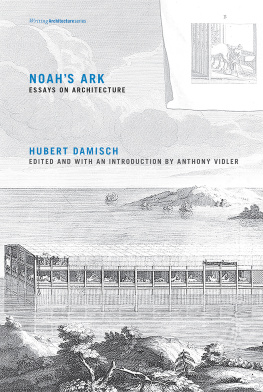ARCHITECTURE

Also in this series:
(Practical Applications)
Agriculture
Art
Education
Medicine
Religion
Science
Social and Political Science
(Esoteric)
Alchemy
Atlantis
Christian Rozenkreutz
The Druids
The Goddess
The Holy Grail
RUDOLF STEINER
ARCHITECTURE
An Introductory Reader
Compiled with an introduction,
commentary and notes by
Andrew Beard
Sophia Books
All translations revised by Matthew Barton
Sophia Books
An imprint of Rudolf Steiner Press
Hillside House, The Square
Forest Row, RH18 5ES
www.rudolfsteinerpress.com
Published by Rudolf Steiner Press 2012
For earlier English publications of individual selections please see Sources
The material by Rudolf Steiner was originally published in German in various volumes of the GA (Rudolf Steiner Gesamtausgabe or Collected Works) by Rudolf Steiner Verlag, Dornach. This authorized volume is published by permission of the Rudolf Steiner Nachlassverwaltung, Dornach (for further information see Note Regarding Rudolf Steiners Lectures)
This edition translated Rudolf Steiner Press 2003
All rights reserved. No part of this publication may be reproduced, stored in a retrieval system, or transmitted, in any form or by any means, electronic, mechanical, photocopying or otherwise, without the prior permission of the publishers
A catalogue record for this book is available from the British Library
ISBN 978 1 85584 341 7
Cover design by Andrew Morgan Design
Typeset by DP Photosetting, Aylesbury, Bucks.
Contents
Part Two
The Temple Legend: underlying esoteric aspects of Steiners vision
Introduction
By Andrew Beard
The contents of this book are drawn mainly from lectures given at different times and places between 1905 and 1924. They are assembled under what I hope are useful headings, allowing the reader to navigate through a landscape with many different features.
Part One begins with Steiners understanding of the nature and origins of architecture. From there it moves to a discussion of how architectural forms affect and influence the human being and how this influence has accompanied mankinds cultural development. Chapters 4-7 are concerned with Steiners view of the spiritual dimension of architecture and its task in our present age, particularly his interest in finding architectural expression for processes of metamorphic change and evolution. In chapters 8-10 Steiner talks directly about his two major architectural works, the first and second Goetheanum buildings and the community of buildings around them.
Part Two is based on the Temple Legend, relating to the origins of human life on earth and containing an image of the human being as a temple in which the divinity is represented by the human I or ego. According to this legend the future of humanity depends on recovering and restoring the lost temple of the human body and the earth.
Rudolf Steiner and the modern movement in art and architecture
Rudolf Steiners architectural work can be seen in the context of the pioneering days of modern architecture. His active period as an architect, from around 1907 to 1924 coincides with landmark buildings by Walter Gropius, Le Corbusier and Frank Lloyd Wright, among others. Most historians who have sought to place his work have identified connections with an earlier generation of art nouveau artists and designers such as Victor Horta in Belgium, Charles Rennie Mackintosh in Scotland and others. Steiners work has also been seen as part of the expressionist stream whose members can be said to include Antonio Gaudi, Saint Elia, Herman Finsterlin, the earlier work of Erich Mendelsohn, Hans Scharoun and Eero Saarinen. Steiners Goetheanum buildings could be seen as built examples of the Volkhaus (house of the people) or Stadtkrone (city crown) advocated by Bruno Taut, among others, as cultural centres representing secular versions of the medieval cathedral. Other, more recent names could be added to the list of architects whose work includes expressionist elements, such as the American Frank Gehry, who built the well-known Guggenheim Museum in Bilbao, the Hungarian Imre Makovecz, the Spanish architect Santiago Calatrava and recent work by the Italian Renzo Piano, co-designer of the high-tech Centre Pompidou in Paris.
As time goes on, however, it is possible that Steiners work may be seen in a broader context than art nouveau, which preceded it, and early expressionism with which it coincided. In common with all the pioneers of modern art and architecture Steiner railed against the degeneracy of most nineteenth-century architecture, with its eclectic plagiarism of former styles. Our present age, he believed, requires a complete renewal of all the arts,
Le Corbusier is one example of an architect who is not necessarily thought of as working from a spiritual perspective. However, the spiritual dimension embraced by many pioneers of twentieth-century art and design is now becoming better known and understood. Kandinskys essay Concerning the Spiritual in Art is a well-known example, but there are many others.

Detail of the second Goetheanum building begun in 1925 by Rudolf Steiner

TWA airline terminal at JFK Airport New York, by Eero Saarinen, 1956-62

Le Corbusiers Modulor Man, as he became known, showing the relationship between the human body and the proportions of the golden section.
A more direct connection can be argued between Steiners architectural work and the so-called organic stream. In the sense that organic architecture is inspired by natural forms, particularly plant forms, comparisons can be made between art nouveau buildings and Steiners first Goetheanum. Steiners interest in morphology, however, went beyond the outer appearance of natural forms and was more concerned with the laws according to which forms come into being. This particular interest was shared by the Chicago architect Louis Sullivan, who was responsible for the aphorism Form follows function. This expression has been interpreted in different ways by different architects but Steiner would have said that form is a direct outcome of the activity it supports and the context in which it arises, without any preconceptions by the designer, including a preconceived style. In this sense organic architecture does not so much involve imitating the external appearance of natural forms but getting inside natures skin and applying her methods to produce a unique solution to each problem. Here, Steiner can be placed alongside masters like Frank Lloyd Wright, Alvar Aalto, Hugo Haaring and Hans Scharoun.
The central importance of metamorphosis
Morphology (the science of the form of plants and animals) is an aspect that Steiner saw as central to his intentions as a designer, and was also of interest to other contemporaries. As well as Sullivan and, interestingly, Le Corbusiers teacher Charles LEplattenier among others, there was the English scientist DArcy Wentworth Thompson whose book On Growth and Form was first published in 1917. Steiners main inspiration, however, was derived from Goethes scientific work, specifically his discovery of the metamorphic process of development in plant growth and, subsequently, in a number of other natural phenomena which take place in time. In fact it became clear to Goethe that metamorphic change underlies
Next page
